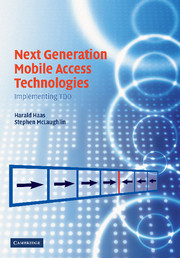Book contents
- Frontmatter
- Contents
- List of abbreviations
- Acknowledgements
- 1 Introduction
- 2 Wireless telecommunications using CDMA and TDD techniques
- 3 Interference and capacity analyses
- 4 Centralised DCA algorithm using the TS-opposing idea
- 5 Distributed DCA algorithm utilising the TS-opposing idea
- 6 UTRA-TDD Opportunity-Driven Multiple Access (ODMA)
- 7 Routing strategies in multi-hop CDMA networks
- 8 Multi-hop DCA
- 9 Radio resource metric estimation
- 10 Interference-based cancellation techniques for TDD
- 11 Smart Antennas for TDD-CDMA Systems
- 12 Cellular OFDMA-TDD
- 1 Derivation of T: Unconstrained Optimisation
- Bibliography
- Index
4 - Centralised DCA algorithm using the TS-opposing idea
Published online by Cambridge University Press: 02 September 2009
- Frontmatter
- Contents
- List of abbreviations
- Acknowledgements
- 1 Introduction
- 2 Wireless telecommunications using CDMA and TDD techniques
- 3 Interference and capacity analyses
- 4 Centralised DCA algorithm using the TS-opposing idea
- 5 Distributed DCA algorithm utilising the TS-opposing idea
- 6 UTRA-TDD Opportunity-Driven Multiple Access (ODMA)
- 7 Routing strategies in multi-hop CDMA networks
- 8 Multi-hop DCA
- 9 Radio resource metric estimation
- 10 Interference-based cancellation techniques for TDD
- 11 Smart Antennas for TDD-CDMA Systems
- 12 Cellular OFDMA-TDD
- 1 Derivation of T: Unconstrained Optimisation
- Bibliography
- Index
Summary
Introduction
This chapter aims to exploit the key finding of Chapter 3 and apply it to the TDD air interface of UMTS (UTRA-TDD). The significant finding of the previous chapter is that ideal synchronisation is not necessarily a prerequisite to obtaining the maximum capacity in a TD-CDMA/TDD network. This has led the author to develop a novel technique which is called the time slot (TS)-opposing method. In this chapter this method is used to develop a centralised dynamic channel assignment (DCA) algorithm.
The approach in this chapter is as follows: first, in section 4.2 a simple centralised DCA algorithm used in a single cell is studied. This investigation aims to find an upper bound of the network performance when combining the TS-opposing technique with a DCA algorithm. Second, in section 4.3 the TS-opposing algorithm is investigated in a cellular TD-CDMA/TDD network. For this approach it is assumed that a group of BSs (following the so called bunch concept (Mihailescu et al., 1999)) is connected to a radio network controller (RNC).
TS-opposing technique applied to a single cell
In this investigation an idealised deployment scenario is assumed to investigate the new TS-opposing mechanism. This means that a TS-opposing algorithm is employed with the aim of improving the capacity only with respect to a single cell. The capacity obtained thereby is then compared with the capacity of an equivalent FDD interface.
A cluster of seven hexagonal cells is assumed with the cell of interest (COI) in the centre.
- Type
- Chapter
- Information
- Next Generation Mobile Access TechnologiesImplementing TDD, pp. 95 - 134Publisher: Cambridge University PressPrint publication year: 2008



